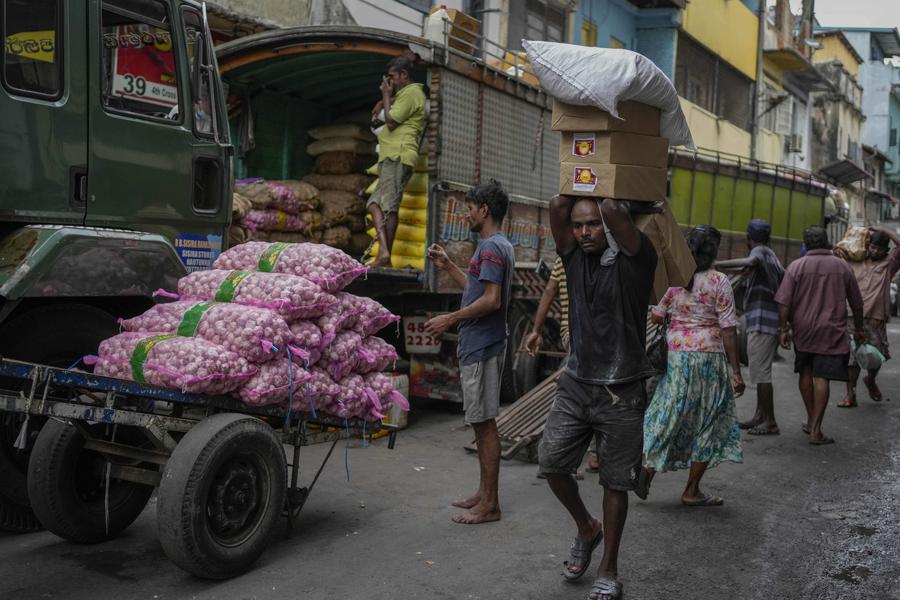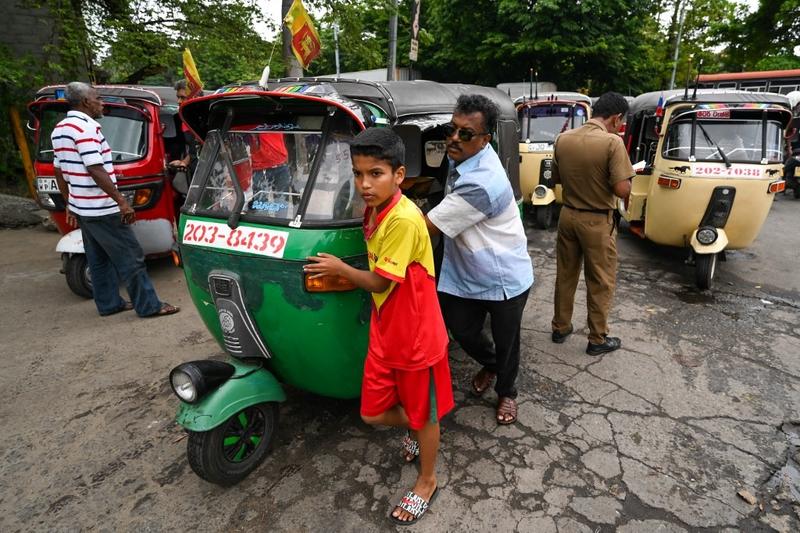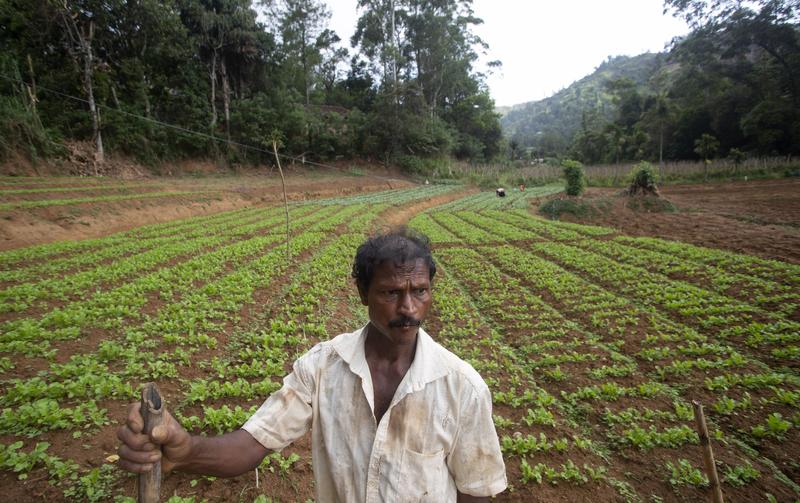 A porter carries a load of imported food items at a marketplace in Colombo, Sri Lanka on July 29, 2022. (ERANGA JAYAWARDENA / AP)
A porter carries a load of imported food items at a marketplace in Colombo, Sri Lanka on July 29, 2022. (ERANGA JAYAWARDENA / AP)
KILINOCHCHI/COLOMBO, Sri Lanka – Nallathambi Mahendran walked through his four acres of emerald green paddy fields in northern Sri Lanka's Kilinochchi district, indicating the height the plants should have reached by now. They were several feet short.
The standing paddy crop across most of this major rice growing belt is stunted for the second successive season because of the lack of fertilizer, according to farmers, a union leader and local government officials.
Compounding the economic misery, the stunted crop means the island will have to use precious currency reserves, a credit line from India as well as foreign aid to import hundreds of thousands of tons of rice
In 10,900 hectares of land under cultivation in Kilinochchi, the average yield is likely to hit 2.3 metric tons per hectare, according to government estimates seen by Reuters.
In previous years, paddy fields in the area delivered around 4.5 tons per hectare, according to a local government official who asked not to be named because he was not authorized to speak to the media.
Across rice farms in this Indian Ocean island, the bleak picture is emerging that the summer harvest could be as low as half that of previous years, according to experts.
As Sri Lanka's staple food, it points to further pressure on a country already struggling with its worst economic crisis in modern times, including runaway inflation and growing levels of malnutrition.
The shortage of fertilizer is not the only problem for farmers.
READ MORE: Sri Lanka gives public workers extra day off to grow food
Compounding the economic misery, the stunted crop means the island will have to use precious currency reserves, a credit line from India as well as foreign aid to import hundreds of thousands of tons of rice.
Across the country, paddy production during the ongoing "Yala" or summer farming season could be half the average 2 million tons in previous years, said Buddhi Marambe, a professor of crop science at Sri Lanka's Peradeniya University.
"This is mainly because of the absence of fertilizer during the vegetative growth stages of the crops," Marambe said. "Urea was made available with lots of effort but was too late for many areas."
This (the paddy production could be only half the avergae 2 million tons in previous years) is mainly because of the absence of fertilizer during the vegetative growth stages of the crops.
Buddhi Marambe,
a professor of crop science at Sri Lanka's Peradeniya University
Sri Lanka has been self-sufficient in rice for decades, but went to international markets last year to buy 149,000 tons of the grain after the fertilizer shortage first hit production. In 2022, the country has already contracted to import 424,000 tons.
More imports may be needed to stave off food shortages in the first two months of 2023, or until the "Maha" crop that is planted in September is harvested, Marambe said.
ALSO READ: Soup kitchens feed Sri Lanka's poor amid bleak economic crisis
A committee appointed by the Ministry of Agriculture is currently evaluating the need for additional imports, a ministry official said, speaking on condition of anonymity.
Government spokespersons did not respond to requests for comment on the food situation and likely imports.
Rice is the staple food of the country's 22 million people and its biggest crop. According to government data, 2 million people in the country are rice farmers out of 8.1 million people engaged in fishing and agriculture in the largely rural economy.
 Motorists queue up along a street to buy fuel from Lanka IOC fuel station in Colombo on Aug 1, 2022.
(ISHARA S. KODIKARA / AFP)
Motorists queue up along a street to buy fuel from Lanka IOC fuel station in Colombo on Aug 1, 2022.
(ISHARA S. KODIKARA / AFP)
Worse to come
Food inflation is already at more than 90% year-on-year, according to July data, and the World Food Programme estimates that about 6.7 million Sri Lankans out of a population of 22 million are not eating enough.
Food inflation is already at more than 90% year-on-year, according to July data, and the World Food Programme estimates that about 6.7 million Sri Lankans out of a population of 22 million are not eating enough
There may be more pain to come.
Hammered by the potential halving of the "Yala" crop, the shortage of fertilizer and soaring costs for inputs, some farmers in Kilinochchi, a fertile region served by an intricate system of irrigation ponds and canals, are considering sitting out the "Maha" farming season.
"Even though we worked in the paddy fields, we won't make any money," said Mahendran, a tall 67-year-old with a streak of silver in his hair. "If there is no urea or fertilizer available, I won't farm in the Maha season."
The Iranaimadu Farmers' Federation, which represents about 7,500 farming families in the Kilinochchi area, gave the same message to local government officials at a recent meeting.
"Fuel is our biggest problem," said the federation's secretary Mutthu Sivamohan, speaking near a petrol and diesel filling station outside which a queue of vehicles stretched for 3 km along the main road running through Kilinochchi town.
"We can't harvest and we can't sow the next crop," Sivamohan said.
He said most of Kilinochchi district's paddy crop must be harvested within weeks but "no lorries are coming from outside to buy and transport our crop".
Diesel for combine harvesters is being rationed, and fewer trucks are available to transport the rice because of the fuel crunch.
Some critics trace Sri Lanka's unfolding food catastrophe to former President Gotabaya Rajapaksa's decision in April, 2021, to ban chemical fertilizers overnight, part of a drive to make the country's produce more organic.
READ MORE: Sri Lanka: Long queues for gas amid warnings of food shortages
Faced with widespread protests from the farming community, the ban was lifted last November, but not before disrupting supplies and leaving most Sri Lankan farmers without essential fertilizers for last year's "Maha" season.
By April, Sri Lanka's financial crisis had strangled the economy and, with foreign exchange reserves at record lows, Rajapaksa's government failed to procure enough fertilizer.
The lack of hard currency at a time of spiraling prices sparked by the Russia-Ukraine conflict also squeezed imports of essentials including fuel, cooking gas, medicines and food.
 A Sri Lankan vegetable farmer stands in his newly prepared tomato bed in Keppetipola, Sri Lanka on July 1, 2021. ((ERANGA JAYAWARDENA / AP))
A Sri Lankan vegetable farmer stands in his newly prepared tomato bed in Keppetipola, Sri Lanka on July 1, 2021. ((ERANGA JAYAWARDENA / AP))
'Dying every day
The resulting shortages led to an outburst of public anger against the government and once-powerful president, and sometimes violent mass protests eventually forced Rajapaksa to flee the country and quit the presidency.
In Kilinochchi, where the Sri Lankan military maintains an outsized presence – a vestige of a decades-long bloody civil war that ended in 2009 – there were no major anti-government demonstrations.
A bag of urea, previously costing 1,500 rupees, is now 40,000 rupees. A liter of Loyant, a popular rice herbicide, goes for more than 10 times its usual price at 100,000 rupees – when available
But the impact of the crumbling economy has rippled through the hinterland, leaving some farmers who survived the war that killed an estimated 80,000-100,000 people struggling.
To farm 75 acres of land, Chinnathambi Lankeshwaran said he would typically spend around 70,000 Sri Lankan rupees ($197) per acre and recover about 40 bags of rice from each acre.
A combination of shortages and inflation has led to his expenses more than doubling to 200,000 rupees per acre, which now yield only 18-20 bags per because of the lack of fertilizer and pesticides, Lankeshwaran said.
The rising cost of farm inputs is striking, according to estimates provided by several farmers.
ALSO READ: World Bank has no new financing plans for crisis-hit Sri Lanka
A bag of urea, previously costing 1,500 rupees, is now 40,000 rupees. A liter of Loyant, a popular rice herbicide, goes for more than 10 times its usual price at 100,000 rupees – when available.
The price of an empty sack into which farmers put their harvest has trebled to 160 rupees each, and the thread that they used to tie the sacks is sold for more than five times what it used to be at around 1,200 rupees per kilogram.
The black market rate for diesel is hovering around 1,200 rupees ($3.38) per liter, much higher than the authorized pump price of 430 rupees.
But supplies are scarce, and Lankeshwaran said he has 300 bags of wheat stored at home because traders don't have fuel to pick it up.
"In those days, we feared where the bombs would come from," said the 49-year-old farmer, referring to the civil war that displaced his family of four. "Now, we are dying every day."


